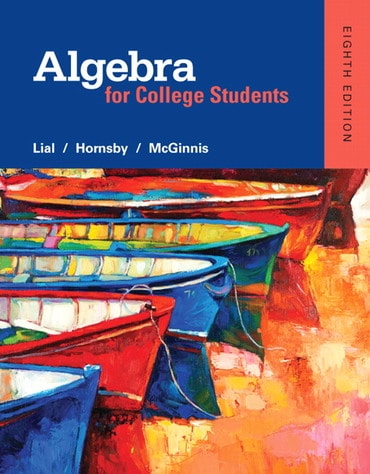Preface
Study Skills: Using Your Math Textbook
R. Review of the Real Number System
R.1 Basic Concepts
R.2 Operations on Real Numbers
R.3 Exponents, Roots, and Order of Operations
R.4 Properties of Real Numbers
Chapter R Summary
Chapter R Test
Study Skills: Reading Your Math Textbook
1. Linear Equations, Inequalities, and Applications
1.1 Linear Equations in One Variable
Study Skills: Completing Your Homework
1.2 Formulas and Percent
Study Skills: Taking Lecture Notes
1.3 Applications of Linear Equations
1.4 Further Applications of Linear Equations
Summary Exercises: Applying Problem-Solving Techniques
1.5 Linear Inequalities in One Variable
Study Skills: Using Study Cards
1.6 Set Operations and Compound Inequalities
Study Skills: Using Study Cards Revisited
1.7 Absolute Value Equations and Inequalities
Summary Exercises: Solving Linear and Absolute Value Equations and Inequalities
Study Skills: Reviewing a Chapter
Chapter 1 Summary
Chapter 1 Review Exercises
Chapter 1 Mixed Review Exercises
Chapter 1 Test
2. Linear Equations, Graphs, and Functions
2.1 Linear Equations in Two Variables
Study Skills: Managing Your Time
2.2 The Slope of a Line
2.3 Writing Equations of Lines
Study Skills: Taking Math Tests
Summary Exercises: Finding Slopes and Equations of Lines
2.4 Linear Inequalities in Two Variables
2.5 Introduction to Relations and Functions
Study Skills: Analyzing Your Test Results
2.6 Function Notation and Linear Functions
Chapter 2 Summary
Chapter 2 Review Exercises
Chapter 2 Mixed Review Exercises
Chapter 2 Test
3. Systems of Linear Equations
3.1 Systems of Linear Equations in Two Variables
Study Skills: Preparing for Your Math Final Exam
3.2 Systems of Linear Equations in Three Variables
3.3 Applications of Systems of Linear Equations
Chapter 3 Summary
Chapter 3 Review Exercises
Chapter 3 Mixed Review Exercises
Chapter 3 Test
Chapters R—3 Cumulative Review Exercises
4. Exponents, Polynomials, and Polynomial Functions
4.1 Integer Exponents and Scientific Notation
4.2 Adding and Subtracting Polynomials
4.3 Polynomial Functions, Graphs, and Composition
4.4 Multiplying Polynomials
4.5 Dividing Polynomials
Chapter 4 Summary
Chapter 4 Review Exercises
Chapter 4 Mixed Review Exercises
Chapter 4 Test
Chapters R—4 Cumulative Review Exercises
5. Factoring
5.1 Greatest Common Factors and Factoring by Grouping
5.2 Factoring Trinomials
5.3 Special Factoring
5.4 A General Approach to Factoring
5.5 Solving Equations by the Zero-Factor Property
Chapter 5 Summary
Chapter 5 Review Exercises
Chapter 5 Mixed Review Exercises
Chapter 5 Test
Chapters R—5 Cumulative Review Exercises
6. Rational Expressions and Functions
6.1 Rational Expressions and Functions; Multiplying and Dividing
6.2 Adding and Subtracting Rational Expressions
6.3 Complex Fractions
6.4 Equations with Rational Expressions and Graphs
Summary Exercises: Simplifying Rational Expressions vs. Solving Rational Equations
6.5 Applications of Rational Expressions
6.6 Variation
Chapter 6 Summary
Chapter 6 Review Exercises
Chapter 6 Mixed Review Exercises
Chapter 6 Test
Chapters R—6 Cumulative Review Exercises
7. Roots, Radicals, and Root Functions
7.1 Radical Expressions and Graphs
7.2 Rational Exponents
7.3 Simplifying Radicals, the Distance Formula, and Circles
7.4 Adding and Subtracting Radical Expressions
7.5 Multiplying and Dividing Radical Expressions
Summary Exercises: Performing Operations with Radicals and Rational Exponents
7.6 Solving Equations with Radicals
7.7 Complex Numbers
Chapter 7 Summary
Chapter 7 Review Exercises
Chapter 7 Mixed Review Exercises
Chapter 7 Test
Chapters R—7 Cumulative Review Exercises
8. Quadratic Equations and Inequalities
8.1 The Square Root Property and Completing the Square
8.2 The Quadratic Formula
8.3 Equations Quadratic in Form
Summary Exercises: Applying Methods for Solving Quadratic Equations
8.4 Formulas and Further Applications
8.5 Polynomial and Rational Inequalities
Chapter 8 Summary
Chapter 8 Review Exercises
Chapter 8 Mixed Review Exercises
Chapter 8 Test
Chapters R—8 Cumulative Review Exercises
9. Additional Graphs of Functions and Relations
9.1 Review of Operations and Composition
9.2 Graphs of Quadratic Functions
9.3 More About Parabolas and Their Applications
9.4 Symmetry; Increasing and Decreasing Functions
9.5 Piecewise Linear Functions
Chapter 9 Summary
Chapter 9 Review Exercises
Chapter 9 Mixed Review Exercises
Chapter 9 Test
Chapters R—9 Cumulative Review Exercises
10. Inverse, Exponential, and Logarithmic Functions
10.1 Inverse Functions
10.2 Exponential Functions
10.3 Logarithmic Functions
10.4 Properties of Logarithms
10.5 Common and Natural Logarithms
10.6 Exponential and Logarithmic Equations; Further Applications
Chapter 10 Summary
Chapter 10 Review Exercises
Chapter 10 Mixed Review Exercises
Chapter 10 Test
Chapters R—10 Cumulative Review Exercises
11. Polynomial and Rational Functions
11.1 Zeros of Polynomial Functions (I)
11.2 Zeros of Polynomial Functions (II)
11.3 Graphs and Applications of Polynomial Functions
Summary Exercises: Examining Polynomial Functions and Graphs
11.4 Graphs and Applications of Rational Functions
Chapter 11 Summary
Chapter 11 Review Exercises
Chapter 11 Mixed Review Exercises
Chapter 11 Test
Chapters R—11 Cumulative Review Exercises
12. Conic Sections and Nonlinear Systems
12.1 Circles Revisited and Ellipses
12.2 Hyperbolas and Functions Defined by Radicals
12.3 Nonlinear Systems of Equations
12.4 Second-Degree Inequalities, Systems of Inequalities, and Linear Programming
Chapter 12 Summary
Chapter 12 Review Exercises
Chapter 12 Mixed Review Exercises
Chapter 12 Test
Chapters R—12 Cumulative Review Exercises
13. Further Topics in Algebra
13.1 Sequences and Series
13.2 Arithmetic Sequences
13.3 Geometric Sequences
13.4 The Binomial Theorem
13.5 Mathematical Induction
13.6 Counting Theory
13.7 Basics of Probability
Chapter 13 Summary
Chapter 13 Review Exercises
Chapter 13 Mixed Review Exercises
Chapter 13 Test
Chapters R—13 Cumulative Review Exercises
Appendix A: Solving Systems of Linear Equations by Matrix Methods
Appendix B: Determinants and Cramer’s Rule
Appendix C: Properties of Matrices
Appendix D: Matrix Inverses
Photo Credits
Answers to Selected Exercises
Index



